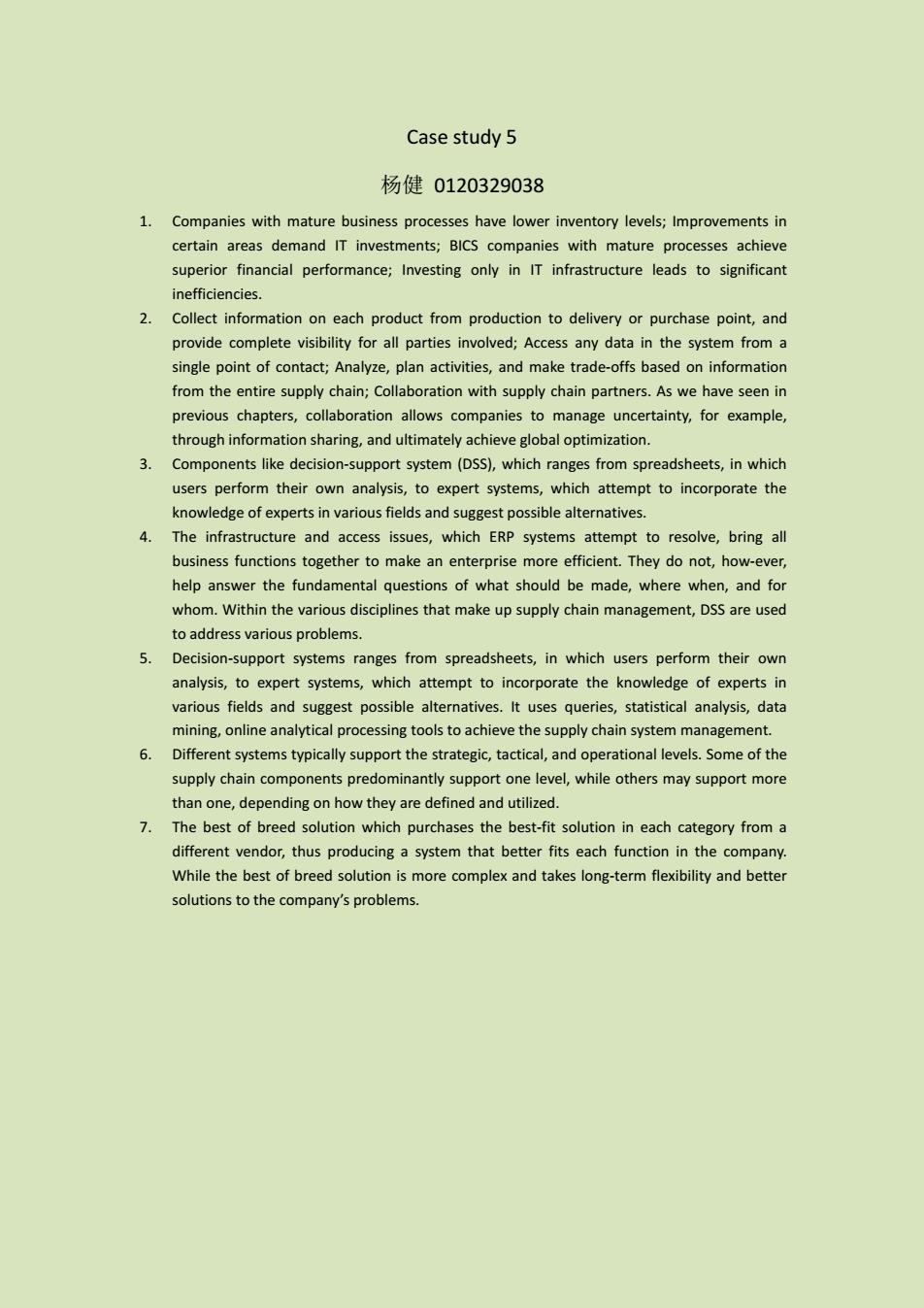正在加载图片...

Case study 5 杨健0120329038 1.Companies with mature business processes have lower inventory levels;Improvements in certain areas demand IT investments;BICS companies with mature processes achieve superior financial performance;Investing only in IT infrastructure leads to significant inefficiencies. 2.Collect information on each product from production to delivery or purchase point,and provide complete visibility for all parties involved;Access any data in the system from a single point of contact;Analyze,plan activities,and make trade-offs based on information from the entire supply chain;Collaboration with supply chain partners.As we have seen in previous chapters,collaboration allows companies to manage uncertainty,for example, through information sharing,and ultimately achieve global optimization. 3.Components like decision-support system(DSS),which ranges from spreadsheets,in which users perform their own analysis,to expert systems,which attempt to incorporate the knowledge of experts in various fields and suggest possible alternatives. 4.The infrastructure and access issues,which ERP systems attempt to resolve,bring all business functions together to make an enterprise more efficient.They do not,how-ever, help answer the fundamental questions of what should be made,where when,and for whom.Within the various disciplines that make up supply chain management,DSS are used to address various problems. 5.Decision-support systems ranges from spreadsheets,in which users perform their own analysis,to expert systems,which attempt to incorporate the knowledge of experts in various fields and suggest possible alternatives.It uses queries,statistical analysis,data mining,online analytical processing tools to achieve the supply chain system management. 6.Different systems typically support the strategic,tactical,and operational levels.Some of the supply chain components predominantly support one level,while others may support more than one,depending on how they are defined and utilized. 7.The best of breed solution which purchases the best-fit solution in each category from a different vendor,thus producing a system that better fits each function in the company. While the best of breed solution is more complex and takes long-term flexibility and better solutions to the company's problems.Case study 5 杨健 0120329038 1. Companies with mature business processes have lower inventory levels; Improvements in certain areas demand IT investments; BICS companies with mature processes achieve superior financial performance; Investing only in IT infrastructure leads to significant inefficiencies. 2. Collect information on each product from production to delivery or purchase point, and provide complete visibility for all parties involved; Access any data in the system from a single point of contact; Analyze, plan activities, and make trade-offs based on information from the entire supply chain; Collaboration with supply chain partners. As we have seen in previous chapters, collaboration allows companies to manage uncertainty, for example, through information sharing, and ultimately achieve global optimization. 3. Components like decision-support system (DSS), which ranges from spreadsheets, in which users perform their own analysis, to expert systems, which attempt to incorporate the knowledge of experts in various fields and suggest possible alternatives. 4. The infrastructure and access issues, which ERP systems attempt to resolve, bring all business functions together to make an enterprise more efficient. They do not, how-ever, help answer the fundamental questions of what should be made, where when, and for whom. Within the various disciplines that make up supply chain management, DSS are used to address various problems. 5. Decision-support systems ranges from spreadsheets, in which users perform their own analysis, to expert systems, which attempt to incorporate the knowledge of experts in various fields and suggest possible alternatives. It uses queries, statistical analysis, data mining, online analytical processing tools to achieve the supply chain system management. 6. Different systems typically support the strategic, tactical, and operational levels. Some of the supply chain components predominantly support one level, while others may support more than one, depending on how they are defined and utilized. 7. The best of breed solution which purchases the best-fit solution in each category from a different vendor, thus producing a system that better fits each function in the company. While the best of breed solution is more complex and takes long-term flexibility and better solutions to the company’s problems